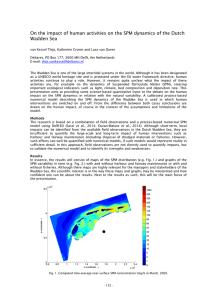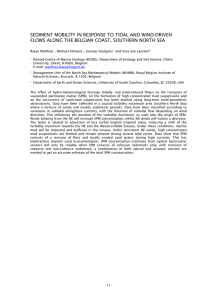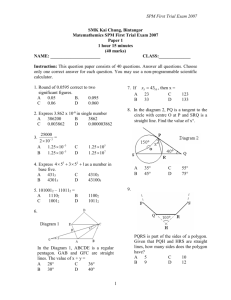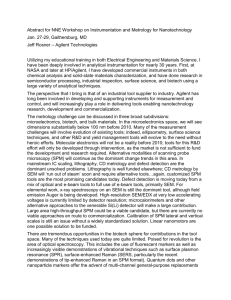Towards a consistent description for dynamics of
advertisement
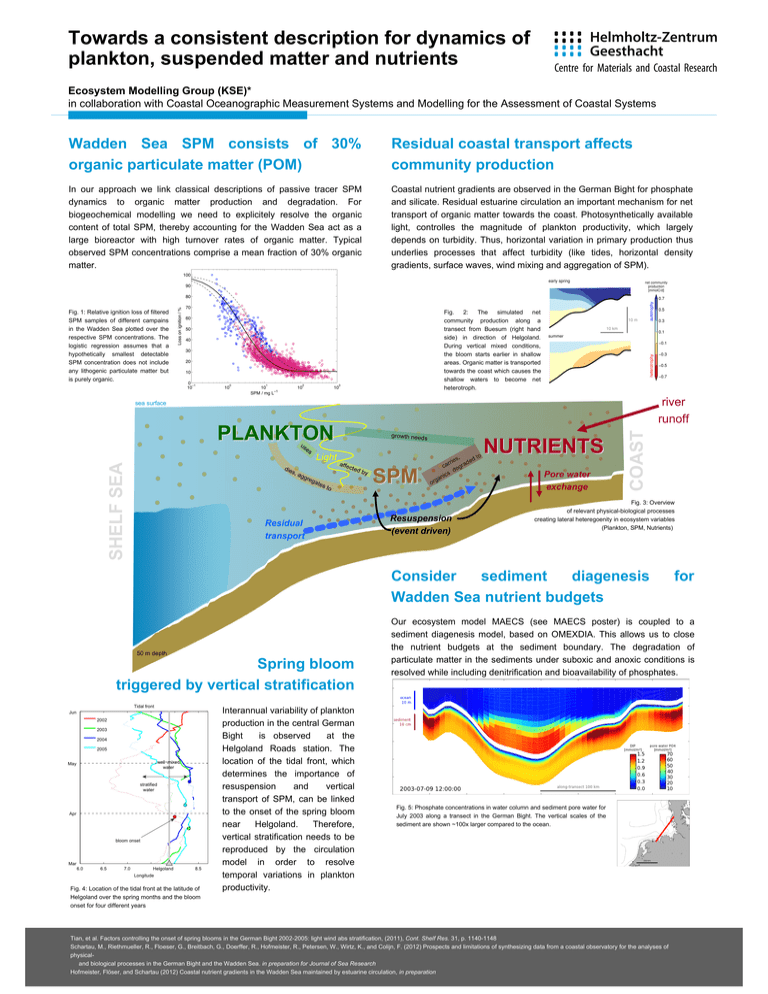
Towards a consistent description for dynamics of plankton, suspended matter and nutrients Ecosystem Modelling Group (KSE)* in collaboration with Coastal Oceanographic Measurement Systems and Modelling for the Assessment of Coastal Systems Wadden Sea SPM consists of 30% organic particulate matter (POM) Residual coastal transport affects community production In our approach we link classical descriptions of passive tracer SPM dynamics to organic matter production and degradation. For biogeochemical modelling we need to explicitely resolve the organic content of total SPM, thereby accounting for the Wadden Sea act as a large bioreactor with high turnover rates of organic matter. Typical observed SPM concentrations comprise a mean fraction of 30% organic matter. Coastal nutrient gradients are observed in the German Bight for phosphate and silicate. Residual estuarine circulation an important mechanism for net transport of organic matter towards the coast. Photosynthetically available light, controlles the magnitude of plankton productivity, which largely depends on turbidity. Thus, horizontal variation in primary production thus underlies processes that affect turbidity (like tides, horizontal density gradients, surface waves, wind mixing and aggregation of SPM). Fig. 1: Relative ignition loss of filtered SPM samples of different campains in the Wadden Sea plotted over the respective SPM concentrations. The logistic regression assumes that a hypothetically smallest detectable SPM concentration does not include any lithogenic particulate matter but is purely organic. Fig. 2: The simulated net community production along a transect from Buesum (right hand side) in direction of Helgoland. During vertical mixed conditions, the bloom starts earlier in shallow areas. Organic matter is transported towards the coast which causes the shallow waters to become net heterotroph. river runoff PLANKTON SHELF SEA us d ie s, a es ggr Light ega te s growth needs a ffe c te d to Residual transport by SPM o rg to , s d e rri ra d e a c g de ic s n a Resuspension (event driven) NUTRIENTS Pore water exchange COAST sea surface Fig. 3: Overview of relevant physical-biological processes creating lateral heteregoenity in ecosystem variables (Plankton, SPM, Nutrients) Consider sediment diagenesis Wadden Sea nutrient budgets 50 m depth Spring bloom triggered by vertical stratification Fig. 4: Location of the tidal front at the latitude of Helgoland over the spring months and the bloom onset for four different years Interannual variability of plankton production in the central German Bight is observed at the Helgoland Roads station. The location of the tidal front, which determines the importance of resuspension and vertical transport of SPM, can be linked to the onset of the spring bloom near Helgoland. Therefore, vertical stratification needs to be reproduced by the circulation model in order to resolve temporal variations in plankton productivity. for Our ecosystem model MAECS (see MAECS poster) is coupled to a sediment diagenesis model, based on OMEXDIA. This allows us to close the nutrient budgets at the sediment boundary. The degradation of particulate matter in the sediments under suboxic and anoxic conditions is resolved while including denitrification and bioavailability of phosphates. Fig. 5: Phosphate concentrations in water column and sediment pore water for July 2003 along a transect in the German Bight. The vertical scales of the sediment are shown ~100x larger compared to the ocean. Tian, et al. Factors controlling the onset of spring blooms in the German Bight 2002-2005: light wind abs stratification, (2011), Cont. Shelf Res. 31, p. 1140-1148 Schartau, M., Riethmueller, R., Floeser, G., Breitbach, G., Doerffer, R., Hofmeister, R., Petersen, W., Wirtz, K., and Colijn, F. (2012) Prospects and limitations of synthesizing data from a coastal observatory for the analyses of physicaland biological processes in the German Bight and the Wadden Sea. in preparation for Journal of Sea Research Hofmeister, Flöser, and Schartau (2012) Coastal nutrient gradients in the Wadden Sea maintained by estuarine circulation, in preparation * - Helmholtz-Zentrum Geesthacht, Institute of Coastal Research, Ecosystem Modelling Group, Richard Hofmeister, Kai Wirtz, Markus Schartau

